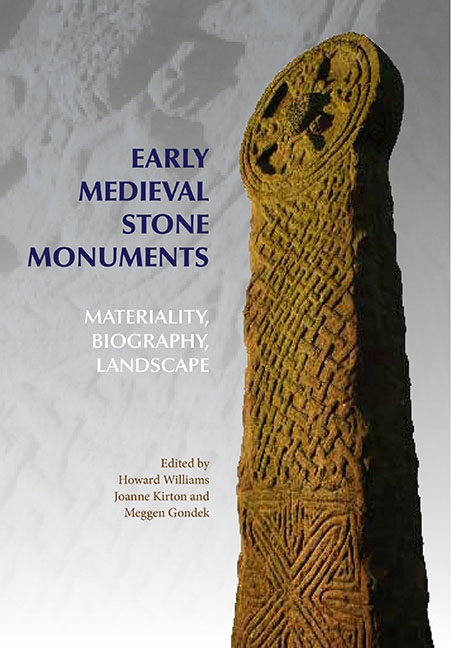Book contents
- Frontmatter
- Dedication
- Contents
- List of Illustrations
- List of Tables
- Acknowledgements
- 1 Introduction: Stones in Substance, Space and Time
- 2 Locating the Cleulow Cross: Materiality, Place and Landscape
- 3 Walking Down Memory Lane: Rune-Stones as Mnemonic Agents in the Landscapes of Late Viking-Age Scandinavia
- 4 Building Blocks: Structural Contexts and Carved Stones in Early Medieval Northern Britain
- 5 Memory, Belief and Identity: Remembering the Dead on Iniscealtra, Co. Clare
- 6 The Biographies and Audiences of Late Viking-Age and Medieval Stone Crosses and Cross-Decorated Stones in Western Norway
- 7 Lifeways in Stone: Memories and Matter-Reality in Early Medieval Sculpture from Scotland
- 8 A Stone in Time: Saving Lost Medieval Memories of Irish Stone Monuments
- 9 Hogbacks: the Materiality of Solid Spaces
- List of Contributors
- Index
6 - The Biographies and Audiences of Late Viking-Age and Medieval Stone Crosses and Cross-Decorated Stones in Western Norway
Published online by Cambridge University Press: 21 May 2021
- Frontmatter
- Dedication
- Contents
- List of Illustrations
- List of Tables
- Acknowledgements
- 1 Introduction: Stones in Substance, Space and Time
- 2 Locating the Cleulow Cross: Materiality, Place and Landscape
- 3 Walking Down Memory Lane: Rune-Stones as Mnemonic Agents in the Landscapes of Late Viking-Age Scandinavia
- 4 Building Blocks: Structural Contexts and Carved Stones in Early Medieval Northern Britain
- 5 Memory, Belief and Identity: Remembering the Dead on Iniscealtra, Co. Clare
- 6 The Biographies and Audiences of Late Viking-Age and Medieval Stone Crosses and Cross-Decorated Stones in Western Norway
- 7 Lifeways in Stone: Memories and Matter-Reality in Early Medieval Sculpture from Scotland
- 8 A Stone in Time: Saving Lost Medieval Memories of Irish Stone Monuments
- 9 Hogbacks: the Materiality of Solid Spaces
- List of Contributors
- Index
Summary
INTRODUCTION
Previous research on the late Viking-Age and medieval stone crosses and cross-decorated slabs of western Norway has focused on the role of the tall crosses and upright cross-slabs as direct markers of Norway's transition to Christianity (Birkeli 1973; Fuglestvedt and Hernæs 1996; Haavaldsen 2000; Rindal and Steinsland 2001; Gabrielsen 2007; but see also Nordeide 2009; 2011). As they have mainly been studied as a source for the Christianization of Norway, limited attention has been given to the use and perception of these monuments throughout the centuries. However, when studying their individual biographies, it transpires that many monuments have been moved, modified and reused – sometimes even very recently – and, thus, must have repeatedly acquired new functions and meanings. The notion that stone crosses and cross-decorated stones continued to affect people long after they were erected is also supported by the folktales and legends that surround a number of them. In addition, existing stone crosses inspired their audiences to erect similar monuments.
While all these aspects could be seen as obstacles in determining a monument's age and primary function, recent studies employing a cultural biographical approach have shown that the changing attitudes towards monuments and the ways in which they accumulate history can provide a better understanding of the dynamic relationship between objects and people, as well as how past actions and alterations to monuments influence conceptions held in the present (Holtorf 1998; Moreland 1999; Hall 2011; 2012). Such an approach is new to the large stone crosses and crossslabs of Norway, where a rather static view of the monuments as silent witnesses to religious and political changes has dominated.
Despite the many problems in dating stone sculpture, it is safe to assume that these crosses and cross-decorated stones were commissioned by individuals or social groups who self-identified as Christians (Nordeide 2009, 176; Fisher 2010, 107). Yet, owing to the fragmented state of the source material, it is not easy to obtain a coherent picture of when and where in Norway Christianity was first introduced. According to the medieval textual sources, Hákon the Good, who was raised in England and reigned from 934 to 961, was Norway's first Christian ruler, although his attempts to Christianize the country are described as less successful than those of his successors Óláfr Tryggvason (995–1000) and Óláfr Haraldsson (1015–1028), who was to become Norway's most beloved saint.
- Type
- Chapter
- Information
- Early Medieval Stone MonumentsMateriality, Biography, Landscape, pp. 149 - 181Publisher: Boydell & BrewerPrint publication year: 2015



